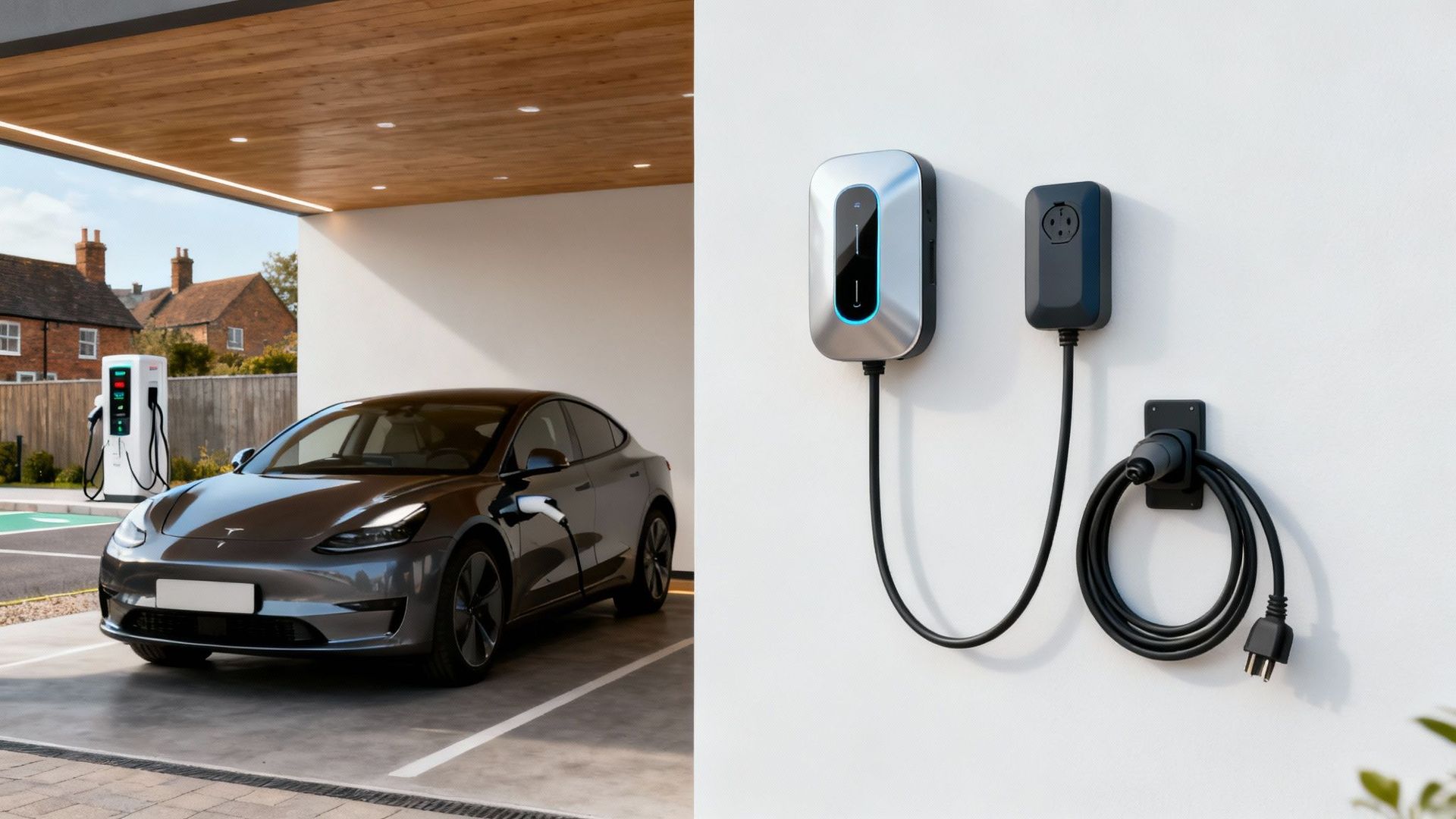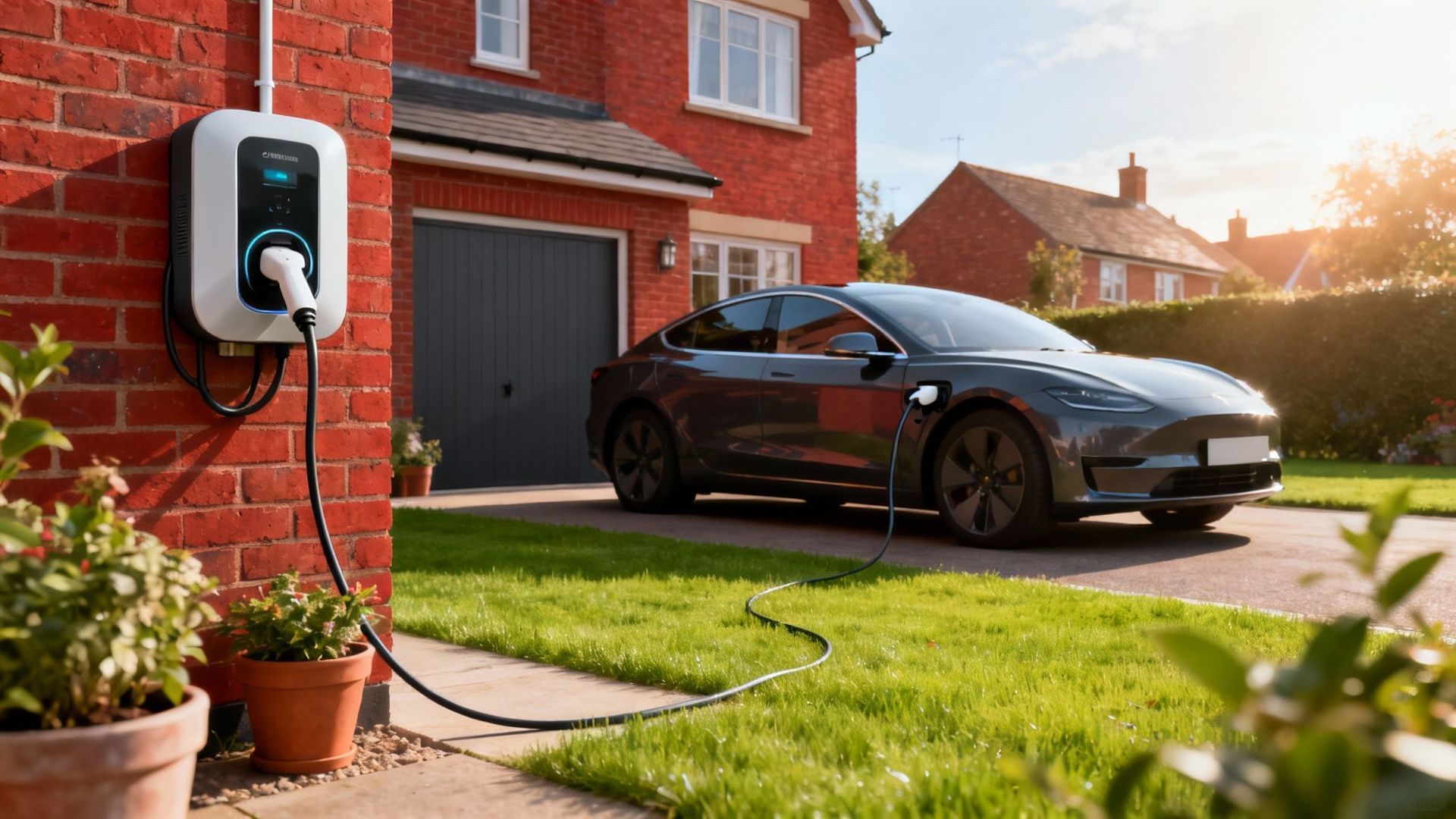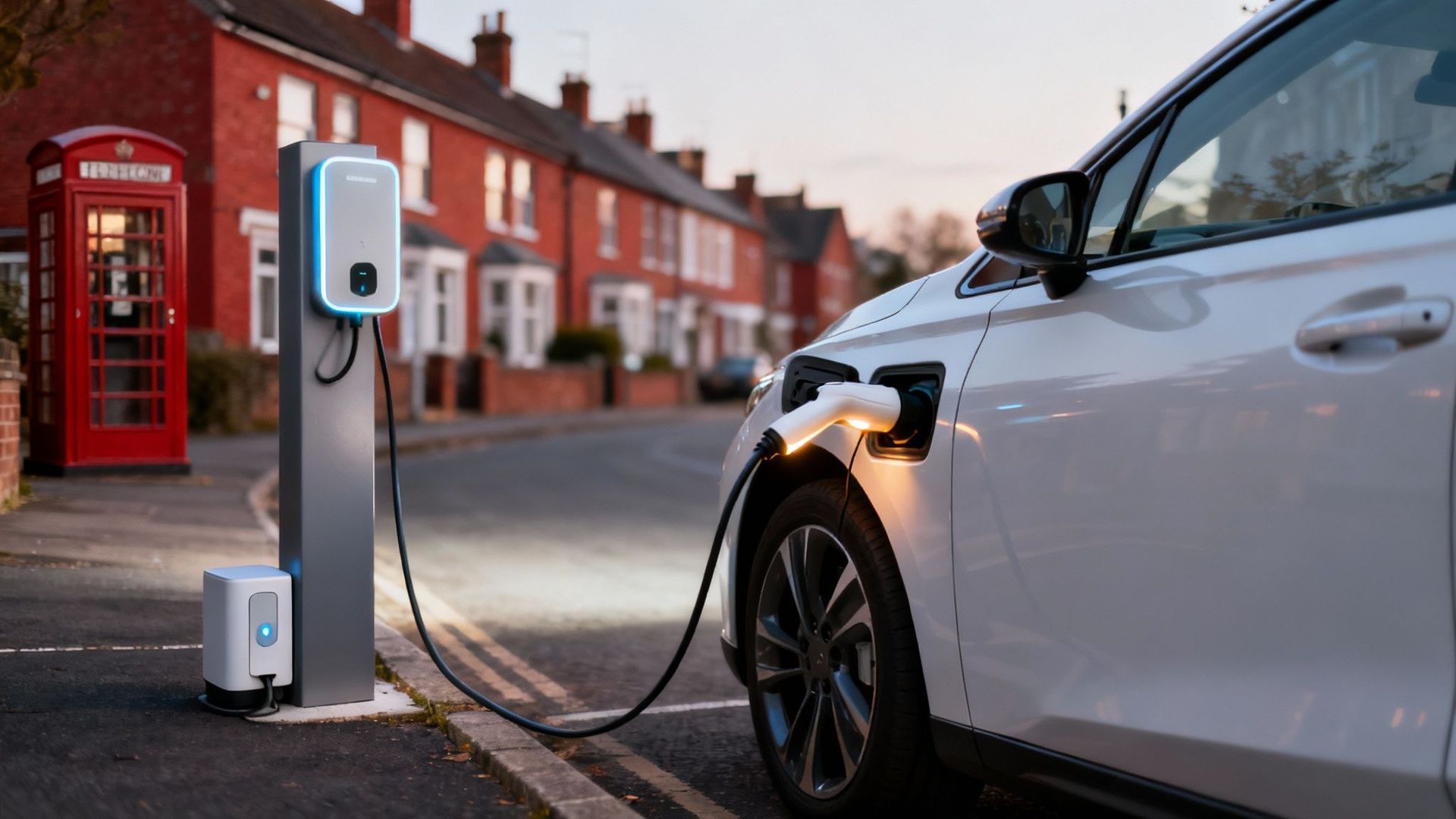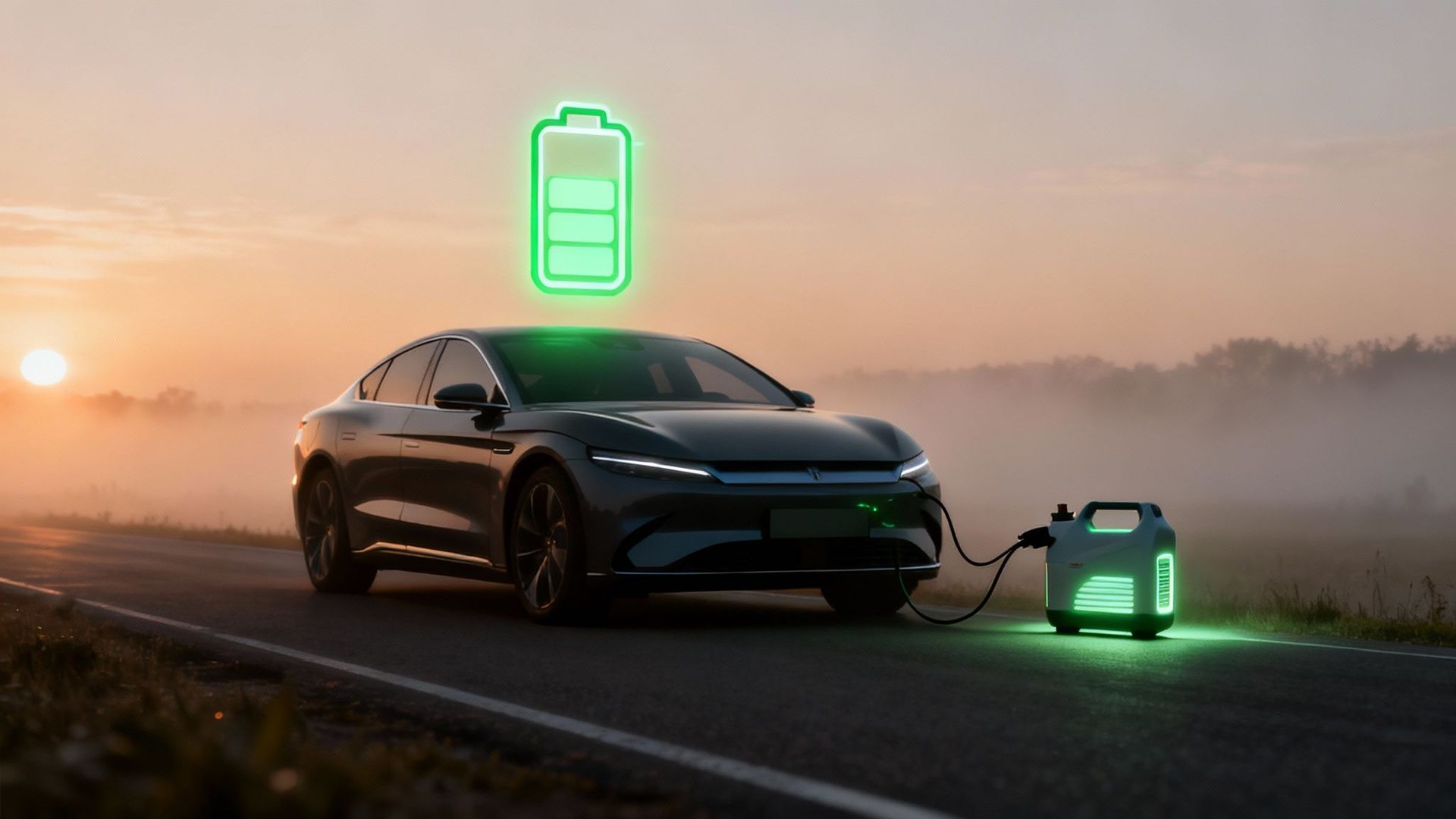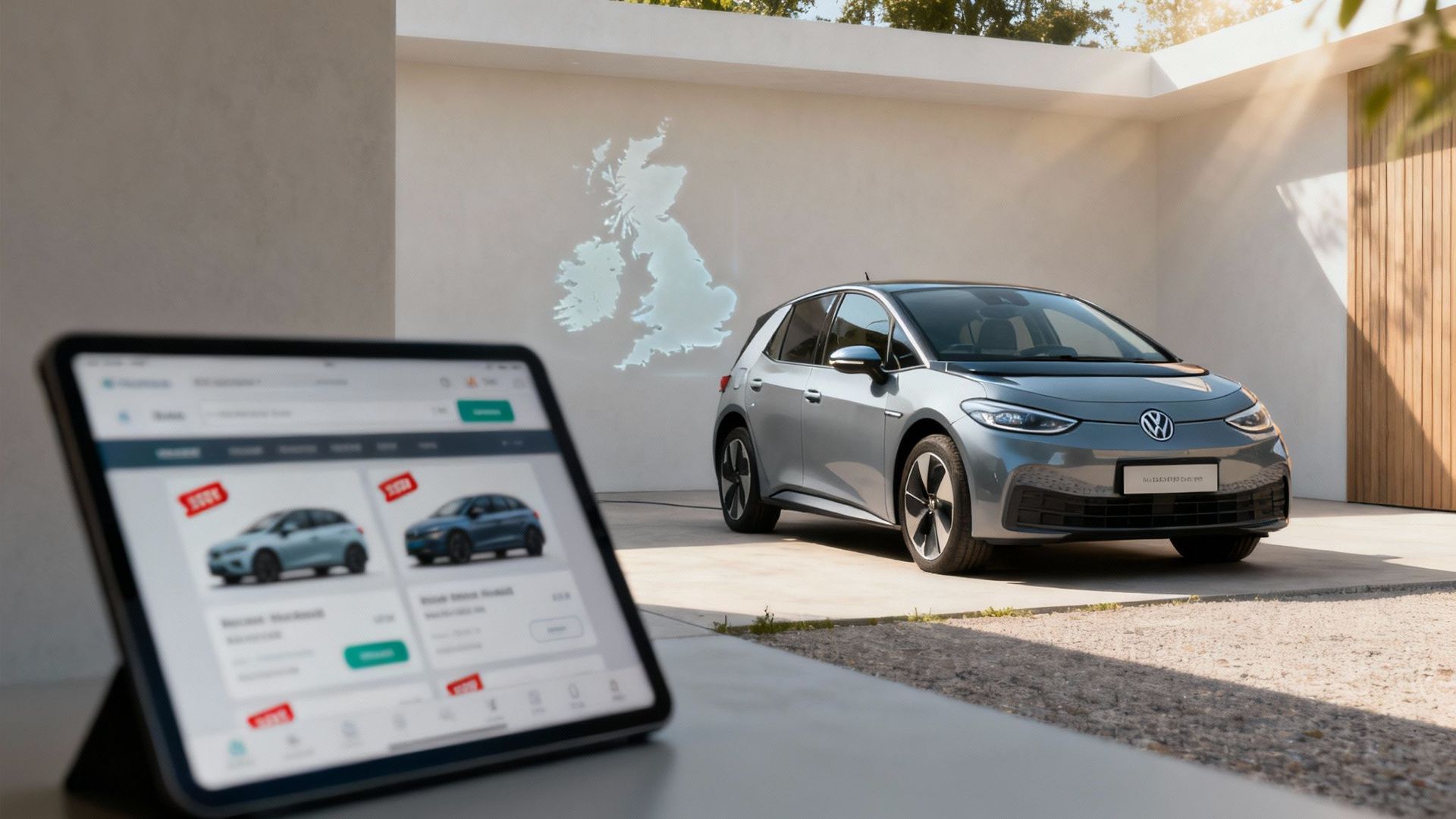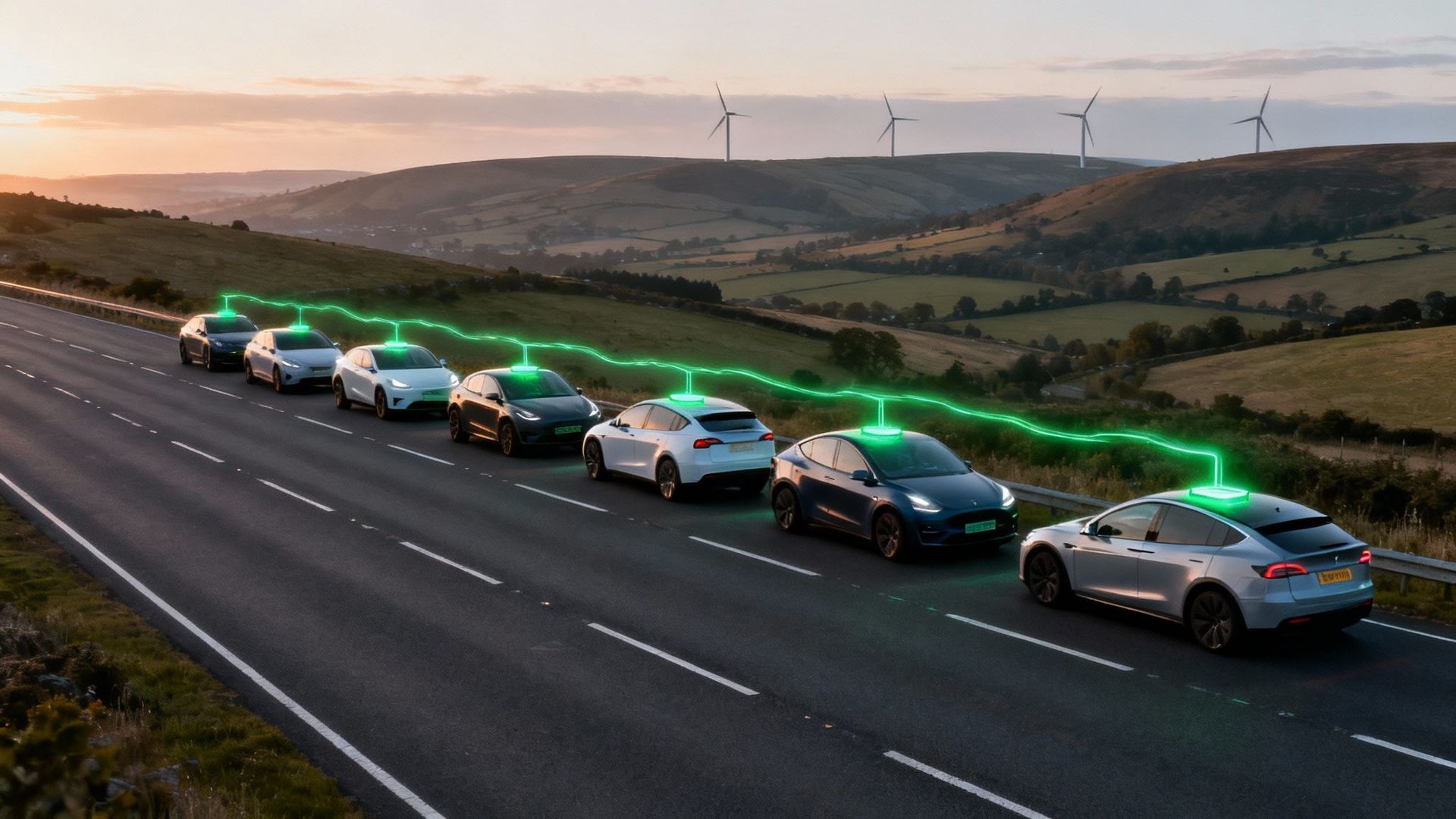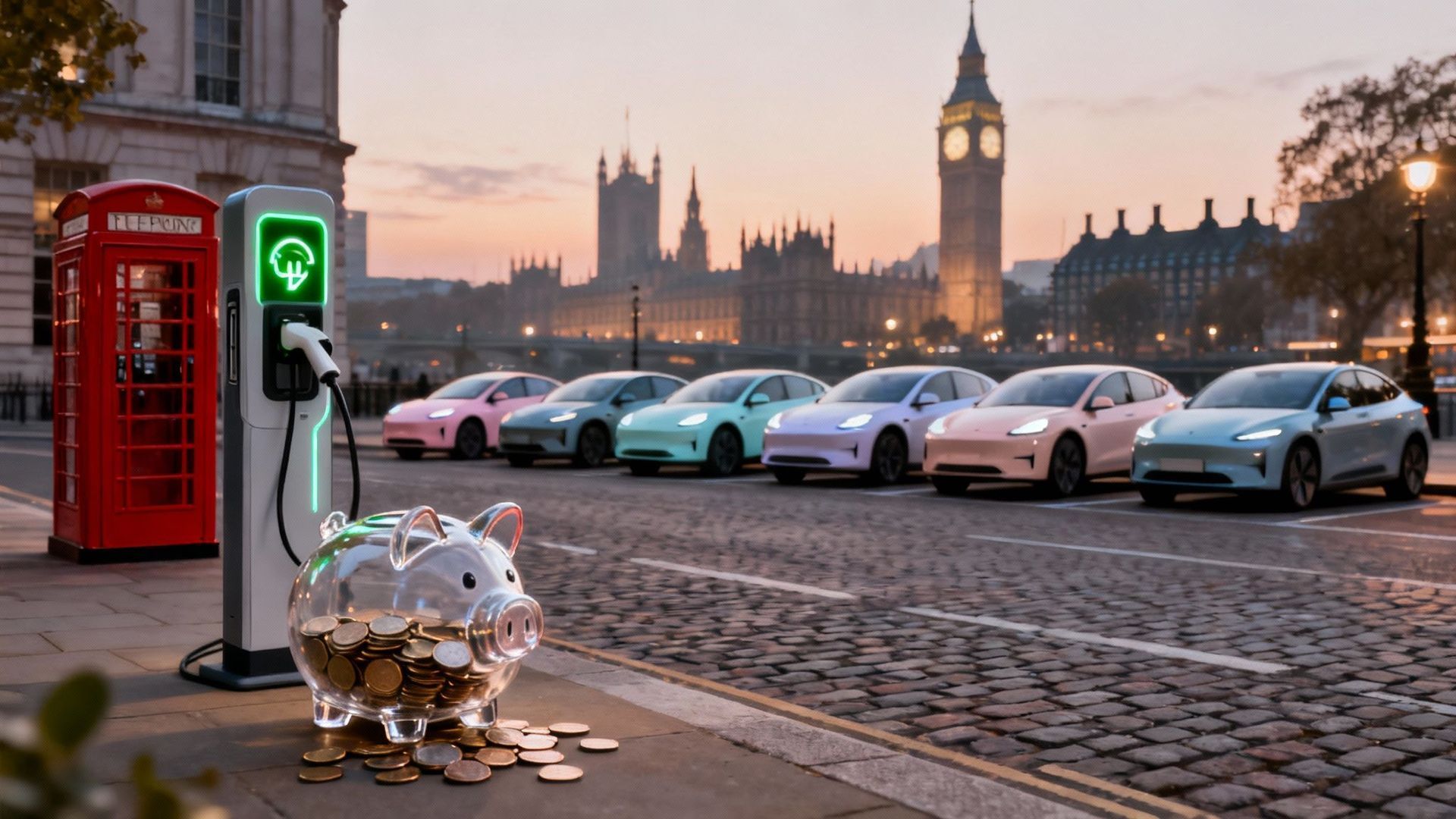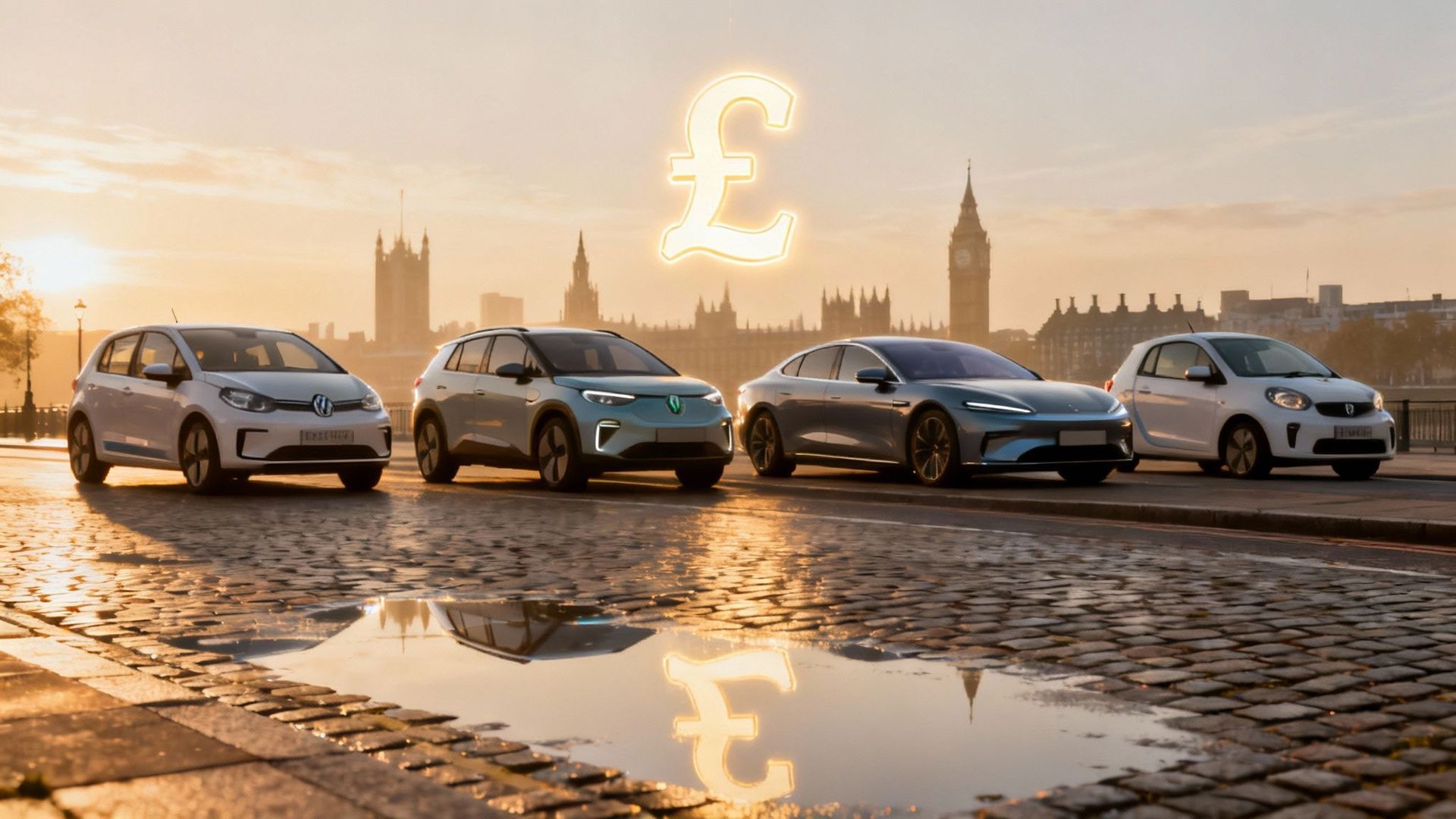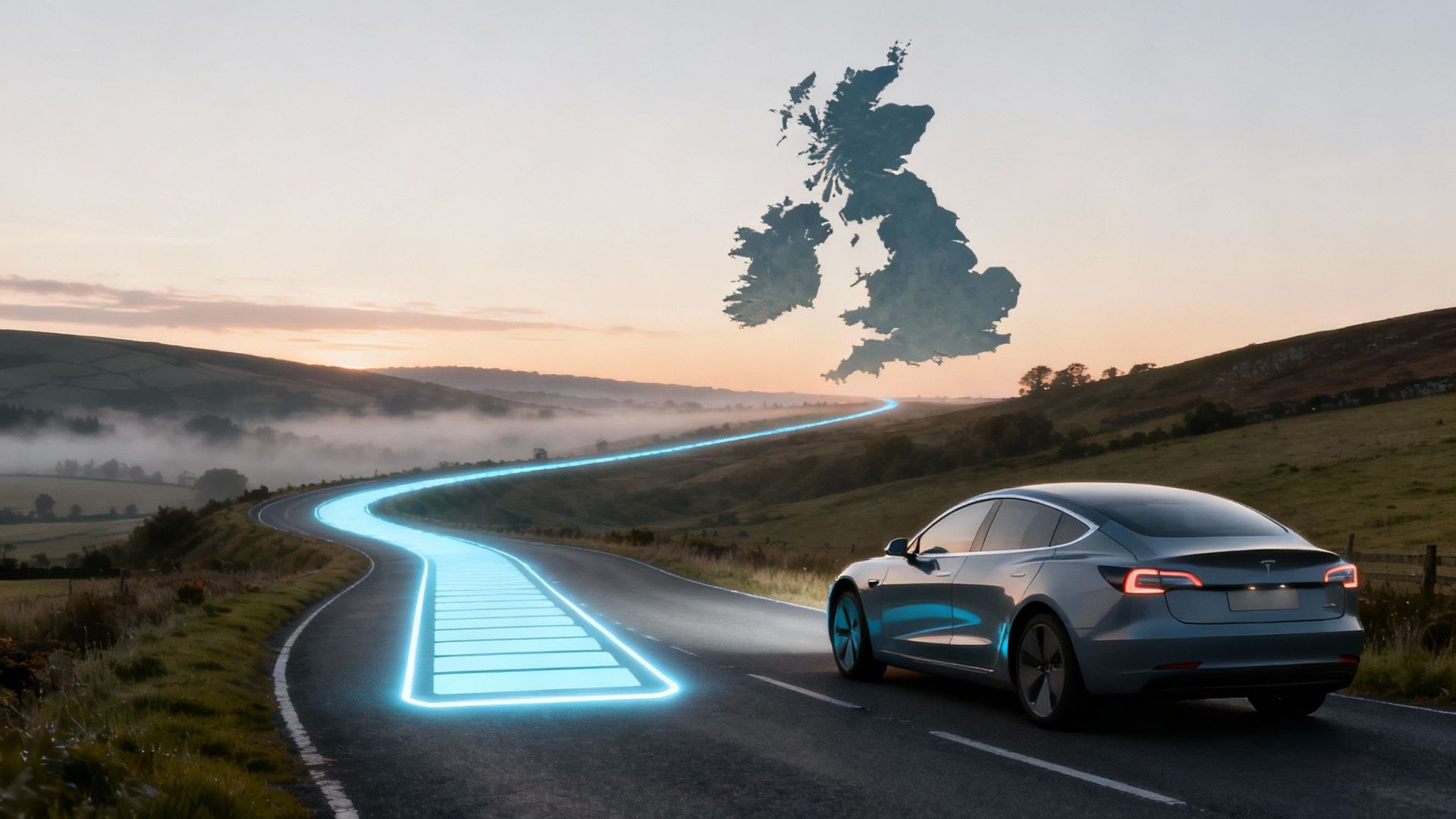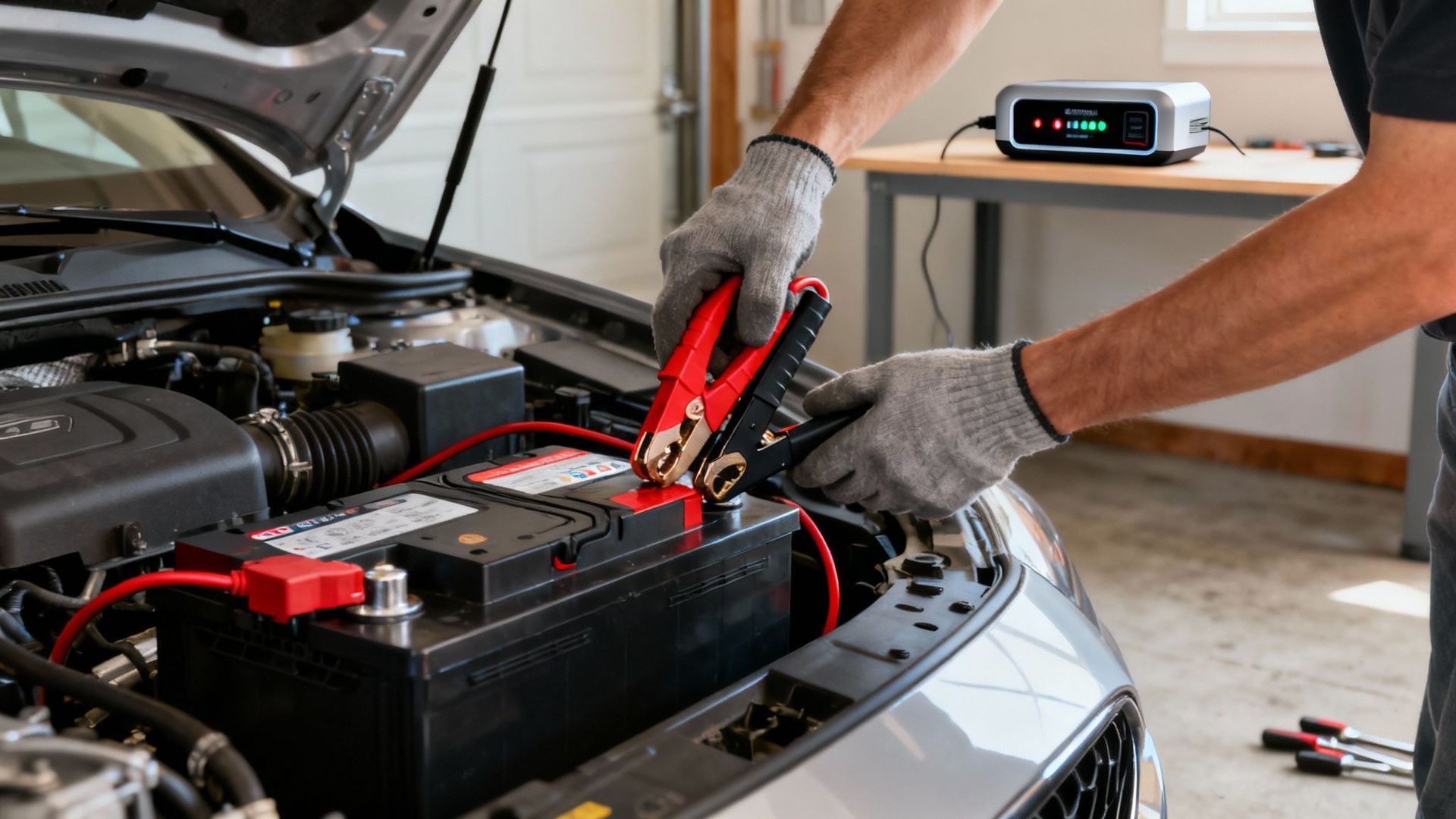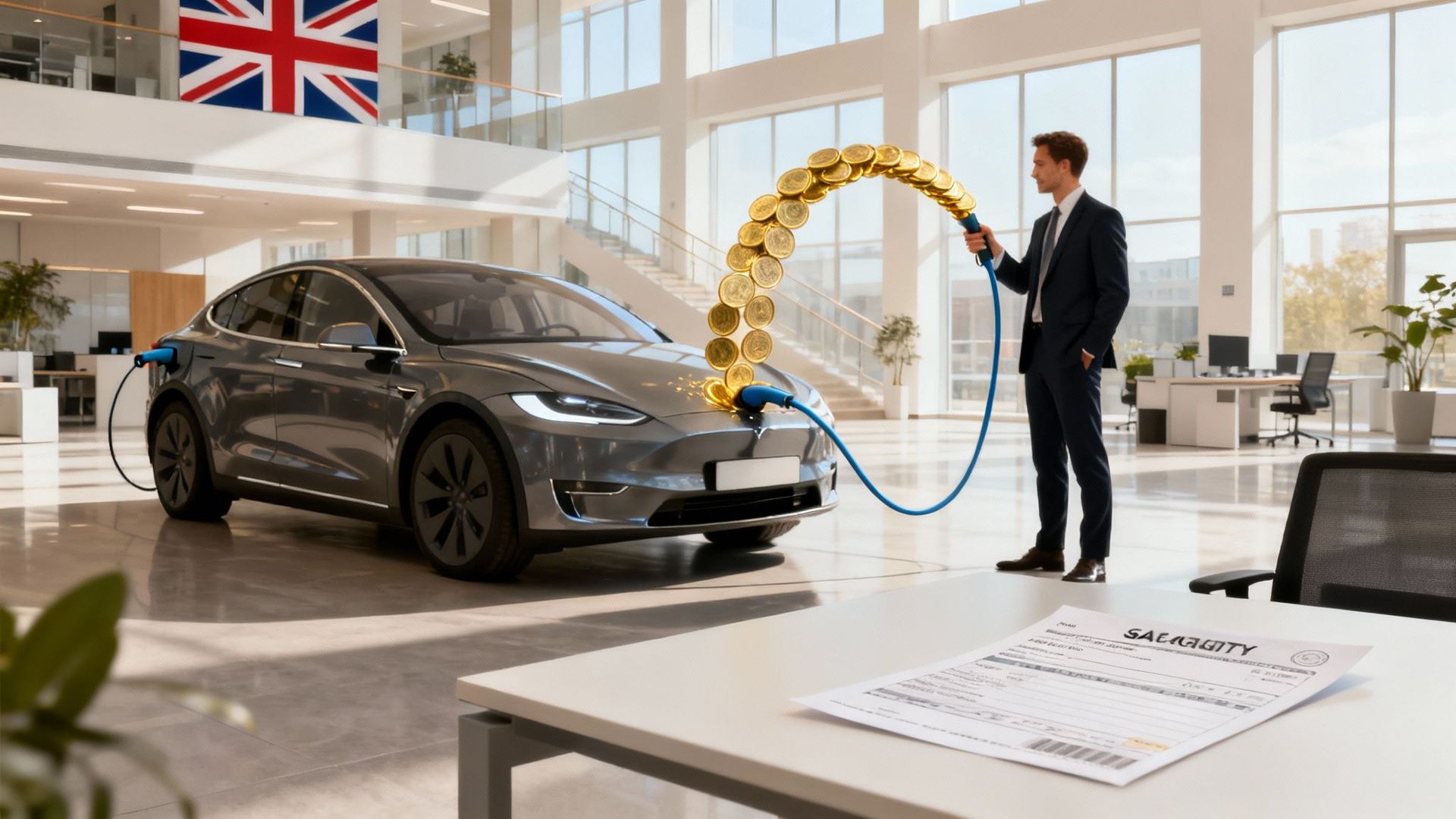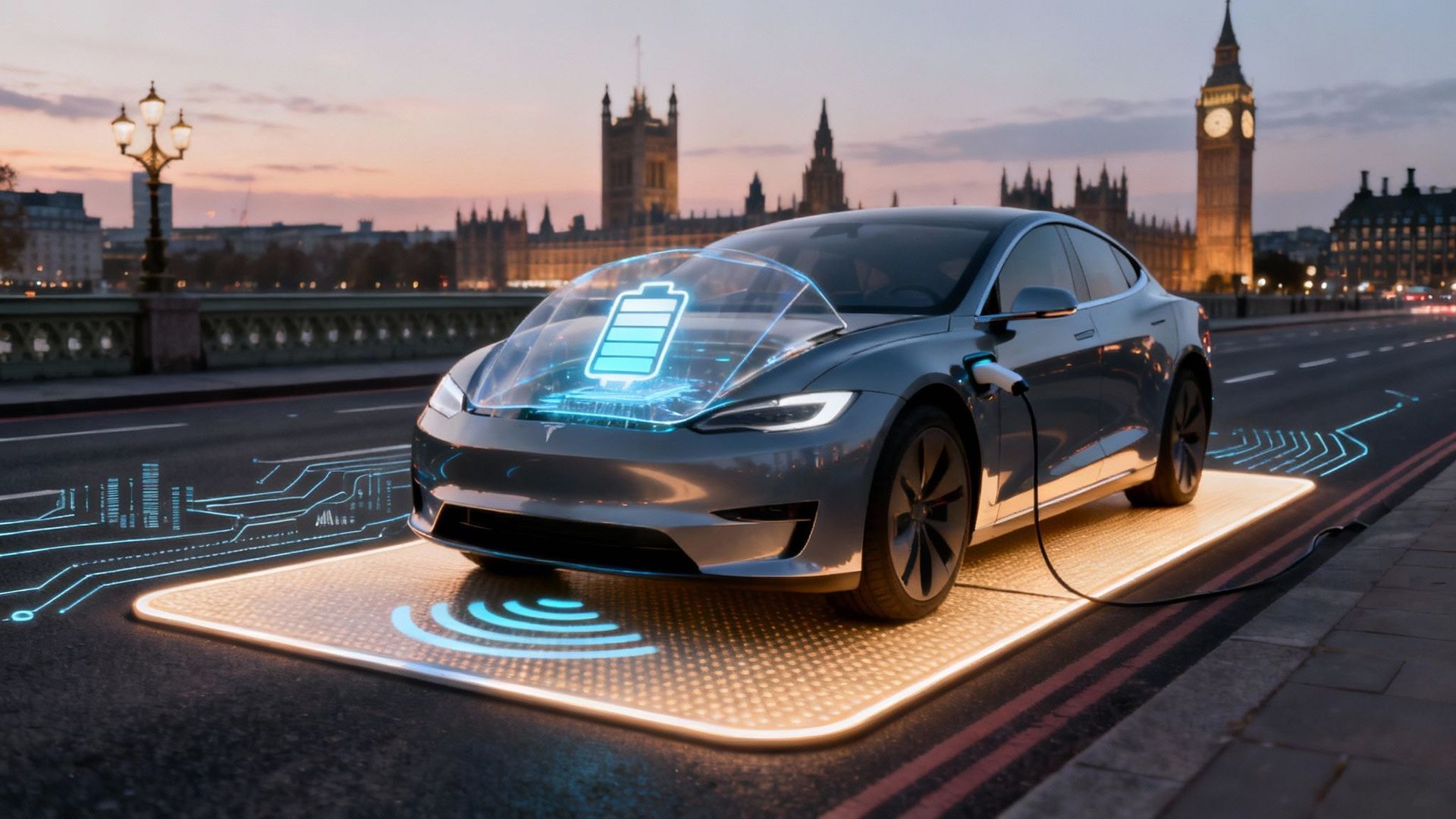Audi Q3 Electric Review: What You Really Need to Know
So, you've been tapping "Audi Q3 electric" into your search bar, hoping to find a fully electric version of Audi’s rather popular compact SUV. A perfectly logical search, but what you’ll actually stumble upon is the Audi Q3 TFSI e , a plug-in hybrid (PHEV). It’s an important distinction and one that causes no end of confusion.
What’s the Story with the "Audi Q3 Electric"?
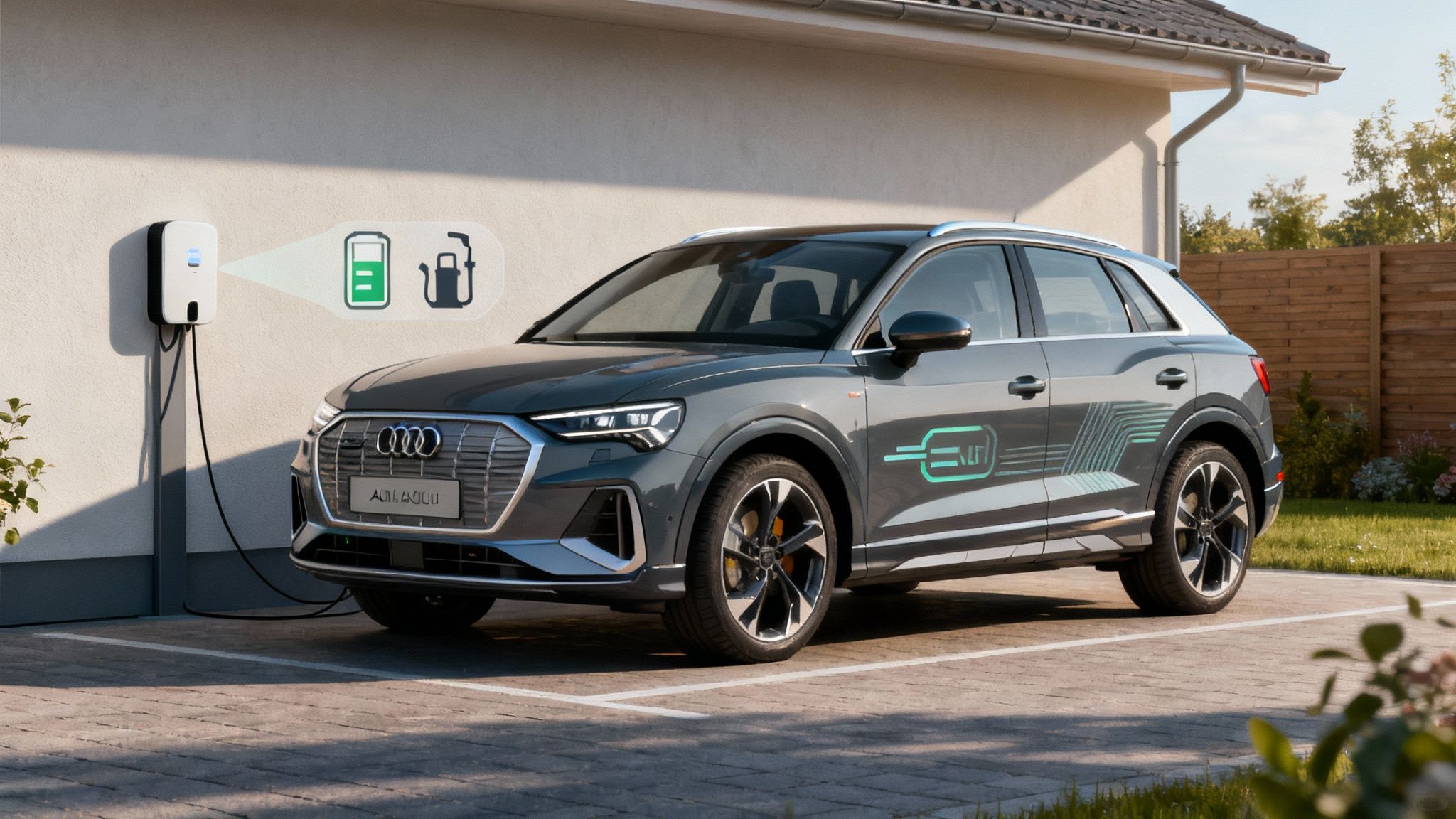
Let's clear this up from the get-go. A pure, battery-only Audi Q3 Electric does not exist. At least, not yet. What Audi has served up is the Q3 TFSI e, a plug-in hybrid that marries a conventional petrol engine with an electric motor and a battery you can charge from the mains.
It’s less a fully electric car and more a car with a split personality. It’s designed to be the perfect stepping stone for drivers who are curious about electric driving but aren't quite ready to sever ties with the petrol pump for good.
Getting the Best of Both Worlds
The thinking behind the Q3 TFSI e is actually rather shrewd. It’s built for the typical UK driver: someone whose daily routine involves the school run, a commute to the office, or a trip to the supermarket – all journeys that can easily be handled on quiet, clean electric power.
But what about that bank holiday weekend jaunt to Cornwall or visiting family up north? That's where the petrol engine rumbles into life, giving you the freedom to travel long distances without meticulously planning your route around charging stations that may or may not be working. This approach directly tackles range anxiety , the number one bogeyman for many people eyeing up an EV.
The plug-in hybrid model isn't just an environmental compromise; it's a very pragmatic financial one. It allows drivers to significantly reduce their daily fuel costs and slash their company car tax bills, without giving up the go-anywhere convenience of a petrol car. It's a clever way to hedge your bets.
What Exactly Is a Plug-in Hybrid?
So, what are we really talking about when we say PHEV? Forget the technical jargon. Think of it as a car with two power sources having a civil partnership under the bonnet.
- The Petrol Engine: A tried-and-tested 1.4-litre turbocharged petrol engine is on standby to take over for longer trips or when you plant your foot and demand maximum performance.
- The Electric Motor & Battery: This is the electric bit of the equation. A decent-sized 13 kWh battery pack powers an electric motor, providing up to 31 miles of pure electric range on a full charge. You top it up by plugging it into a charger, just like a proper EV.
These two systems can work independently or join forces. You can glide silently through town on battery power alone, or the car can combine both for a punchy burst of acceleration on a B-road. It’s a complex but effective solution to the headaches of modern driving.
What Powers the Q3 Hybrid?
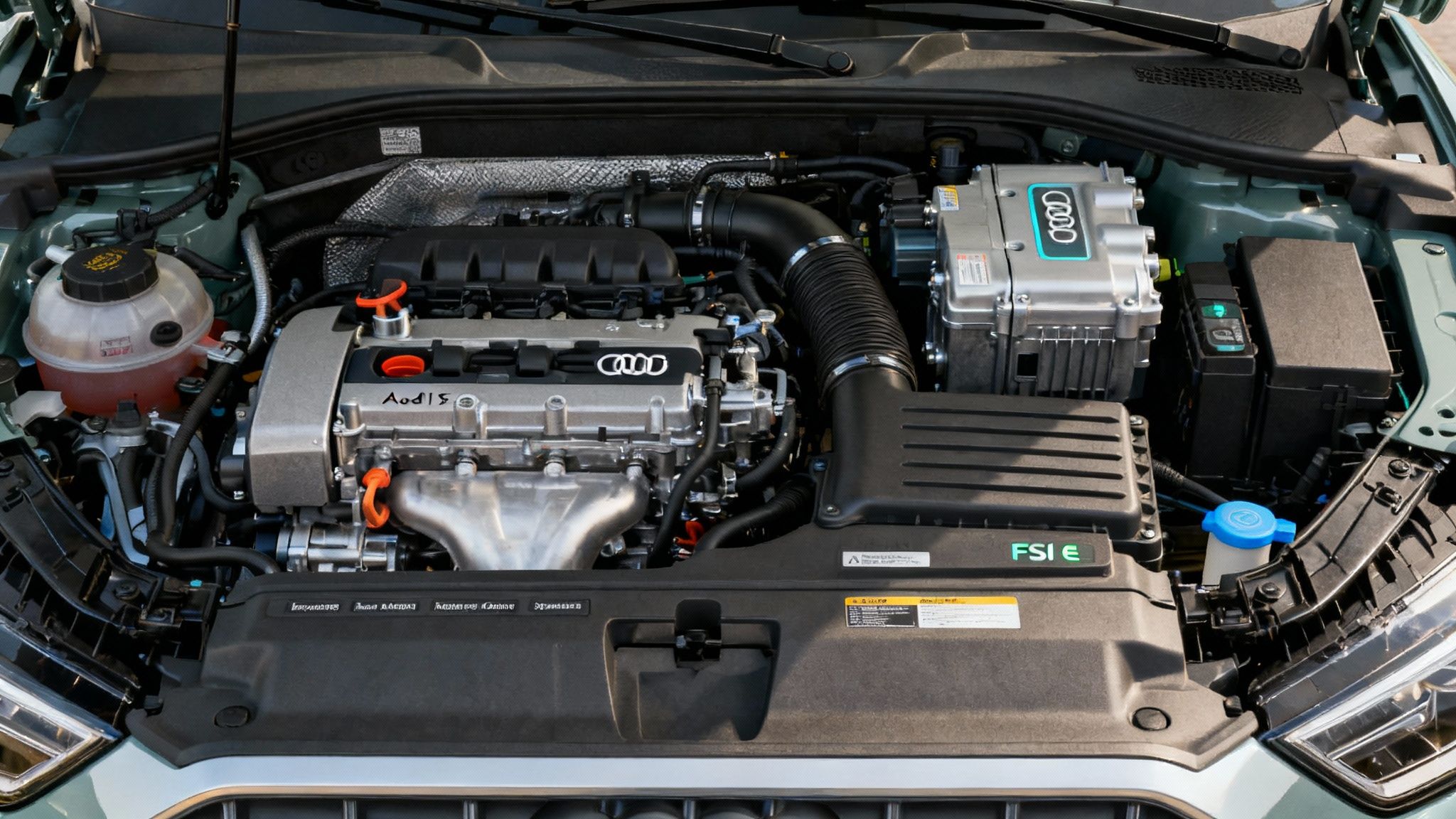
Right, let’s pop the bonnet and have a gander at what makes this Q3 tick. It’s not fully electric, despite what some might call it. Instead, Audi has engineered a clever partnership between a traditional petrol engine and a modern electric motor. Think of it as the best of both worlds, forced to cohabitate under one roof.
At the heart of it all is a familiar 1.4-litre TFSI petrol engine . It’s a solid, reliable four-cylinder unit, but on its own, it’s nothing to write home about. The real story begins when you introduce its partner in crime.
Working alongside the petrol engine is an 85kW electric motor , which gets its juice from a 13kWh battery pack . This is the secret sauce. The motor provides that silent, instant shove for city driving, while the petrol engine is ready to take over for longer motorway journeys or when you need a bit more poke.
How It All Works Together
So, how does this dynamic duo actually perform on the road? It’s far from a clumsy pairing; think of it more like a well-rehearsed dance. The car’s onboard brain is constantly trying to figure out the most efficient way to blend the two power sources.
Pull away with a fully charged battery, and you’ll glide off in pure electric mode. It’s quiet, smooth, and feels wonderfully modern, not to mention cheap to run. You can cruise through urban areas and past schools with a clear conscience, smugly.
But when you need a burst of speed—say, for a swift overtake on a B-road—the petrol engine fires up almost instantly to lend a hand. At that point, the car combines both power sources to give you everything it’s got.
The true test of any good hybrid is how seamlessly it switches between electric and petrol power. A bad one can feel jerky and indecisive, as if the car is having a small argument with itself. Thankfully, Audi has engineered this transition to be buttery smooth; most of the time, you barely even notice it’s happening.
This clever collaboration results in some pretty punchy performance figures. Together, the system puts out a very healthy 245 horsepower and a substantial 400Nm of torque . What does that translate to in the real world?
- 0-62 mph in just 7.3 seconds : That’s more than quick enough to feel brisk and will certainly surprise a few hot hatches at the traffic lights.
- Instant throttle response : The electric motor fills in any potential lag from the petrol engine, making the Q3 feel incredibly responsive from a standstill.
All that power is channelled through a slick six-speed S tronic automatic gearbox. It delivers a smooth, continuous flow of acceleration whether you’re running on electricity, petrol, or a mix of both.
What’s It Like to Drive?
Now for the most important bit: what does it actually feel like from behind the wheel? Some hybrids can feel a bit disconnected and soulless, but Audi has done a fantastic job of making the whole experience feel cohesive. The car is solid, composed, and reassuringly... well, like an Audi should be.
You get a choice of driving modes to match your journey. You can leave it in ‘Hybrid’ and let the car make all the decisions, or you can select ‘EV’ mode to force it to run on electric power alone until the battery is depleted. There’s also a handy ‘Battery Hold’ mode, which saves your electric range for later. This is perfect if you’ve got a long motorway drive before heading into a city’s low-emission zone.
It’s a genuinely practical and thoughtful system that’s perfectly suited to the reality of driving in the UK. The powertrain is a well-executed piece of engineering that delivers the premium, polished experience you expect from a car with four rings on the grille.
Real-World Range and Charging Realities
Right, let's get to the question that really matters for anyone considering a plug-in hybrid. How far can you actually get on pure battery power before the petrol engine has to step in and spoil the silence? We're not talking about the numbers you see in glossy brochures; we mean the real-world range on a cold, wet Tuesday morning commute.
Official figures are always a bit optimistic, aren't they? They're cooked up in a lab under perfect conditions, probably by someone named Klaus. For the Audi Q3 TFSI e , the numbers on paper are genuinely impressive. It pairs a 1.5-litre petrol engine with a hefty 19.7 kWh battery , which is a pretty substantial setup for a plug-in hybrid of this size. This combination allows Audi to claim a class-leading electric-only range of up to 74 miles . You can see how these official figures stack up against the competition here.
The Honest Truth About Range
Now for a dose of reality. While 74 miles sounds fantastic, you'll need a feather-light foot and a strong tailwind to get anywhere close to that. In the real world—with the heating on, music blaring, and navigating the sort of stop-start traffic that defines most British towns—you should probably expect something closer to 30-35 miles of pure electric driving.
This chart gives you a clearer picture of the official claims versus what you'll likely experience day-to-day.
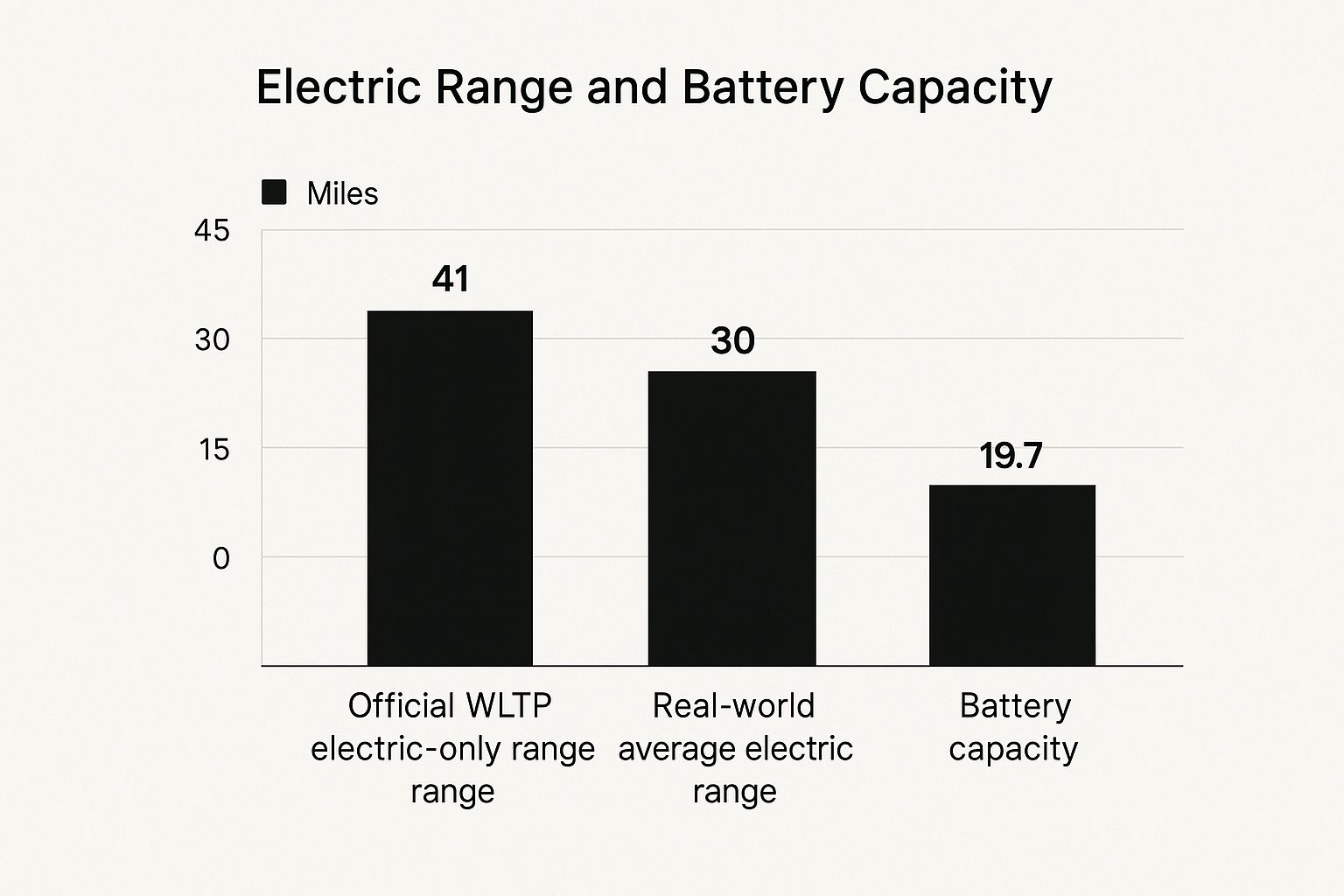
As you can see, the official WLTP figure might be a respectable 41 miles, but a more realistic average settles around the 30-mile mark from that 19.7 kWh battery.
That might seem like a big drop, but it’s important to put it into perspective. The average UK car journey is less than 10 miles. This means for the daily grind—the school run, the commute, the trip to Tesco—you can genuinely use this car as a full EV, rarely troubling the petrol engine. It's only on those longer motorway journeys that its fossil-fuelled half needs to wake up.
Charging: A Tedious but Essential Topic
Owning a plug-in hybrid means, well, you have to plug it in. If you don't, you're just hauling around a heavy, expensive battery for no reason, and you'll get worse fuel economy than the standard petrol model. So, how do you get juice back into the Q3?
You've got a few options, and they vary wildly in speed and convenience.
- The Humble 3-Pin Plug: Yep, you can charge it from a standard household socket. It’s painfully slow, taking about 10 hours for a full charge. It’s fine for an overnight top-up but not much use if you need a quick turnaround.
- A Dedicated Wallbox: This is the sensible choice. Installing a 7kW home wallbox charger will slash the charging time to around 3 hours and 45 minutes . It's the best way to live with a PHEV, ensuring you wake up to a full battery every morning.
- The Public Charging Network: When you're out and about, the Q3 can handle up to 11kW AC charging . Hooking up to one of these public points (often found at supermarkets or service stations) will get you from flat to full in about 2 hours and 30 minutes .
To make the most of the Audi Q3 TFSI e, you've got to charge it regularly. It's as simple as that. Think of it like your phone—plug it in overnight, and you’ll get the benefits of cheap, silent, zero-emission driving for all your daily tasks. If you neglect it, you’ve just bought a very expensive and slightly compromised petrol SUV.
Here’s a quick breakdown of what to expect when you plug in.
Audi Q3 TFSI e Charging Times and Options
This table gives you a clear idea of how long it takes to charge the 19.7 kWh battery using the most common methods available in the UK.
| Charging Method | Charger Power | Approximate Time (0-100%) |
|---|---|---|
| Standard 3-Pin Socket | 2.3 kW | Around 10 hours |
| Home Wallbox | 7 kW | Approx. 3 hours 45 mins |
| Public AC Charger | 11 kW | Approx. 2 hours 30 mins |
Ultimately, living with the electric side of the Q3 is remarkably straightforward, as long as you have somewhere to park and plug it in. It offers a genuinely practical electric range that covers most people's daily needs, making the idea of an "Audi Q3 electric" a very usable reality.
UK Pricing and Company Car Tax
Right, let's get down to the numbers. You’ve seen what the Q3 TFSI e can do, but what does it cost to put one on your driveway? While the initial price is one thing, the real magic for many UK drivers happens when you look at the running costs. This is where the Q3 hybrid starts to feel less like a purchase and more like a very smart investment.
How Much Does It Cost?
The entry ticket for an Audi Q3 TFSI e depends on the trim level you go for. Prices typically start from around £43,000 for the Sport model, which comes with a decent amount of kit as standard. If you want the sportier look of the S line models, with their more aggressive bumpers and bigger wheels, you’ll be looking at something closer to £46,000 . The all-singing, all-dancing Vorsprung trim will push you well over the £50,000 mark.
That's a fair chunk of change, for sure. But when you compare it to the standard petrol or diesel Q3s, the extra you pay for all the clever hybrid tech isn't quite as terrifying as it first seems, especially once you see how it pays you back.
The Company Car Tax Advantage
For business users, this is where the Audi Q3 TFSI e really comes into its own. In the UK, the amount of company car tax you pay is directly linked to your vehicle's CO2 emissions. It’s a simple rule: the lower the emissions, the less the taxman takes. This is known as Benefit-in-Kind (BiK) , and it can be the deciding factor in whether a company car is affordable or a financial millstone.
Because the Q3 TFSI e can zip around on pure electric power, its official CO2 emissions are astonishingly low. It officially clocks in at just 40 to 47 g/km and boasts a fuel economy equivalent of a frankly bonkers 157 mpg , as detailed in Audi's press release.
These figures are a game-changer for company car drivers. It puts the Q3 TFSI e squarely in the 6% company car tax band . That’s a huge win, especially when key rivals like the BMW X1 and Mercedes GLA hybrids often sit in a higher 9% bracket.
For a company car driver, choosing the Q3 TFSI e over a standard petrol or diesel Q3 isn't just a small saving—it's a massive one. You could be saving thousands of pounds every single year, money that stays in your bank account instead of going to HMRC.
To put it simply, the lower your BiK rate, the more of your salary you keep. A higher-rate taxpayer choosing a car in the 6% BiK band instead of a petrol SUV in a 30%+ band will see a colossal difference in their monthly payslip. If you want to get into the nitty-gritty, our guide on UK electric car tax benefits and dodging HMRC breaks it all down.
Deal of the Week
We're always on the lookout for a cracking deal, and this week we’ve found a belter from a major UK leasing firm. They’re offering the Audi Q3 Sport 45 TFSI e on a business contract hire that's pretty hard to walk away from.
- Model: Audi Q3 Sport 45 TFSI e S tronic
- Terms: 36-month lease, 8,000 miles per year
- Initial Rental: £2,694 + VAT
- Monthly Rental: £449 + VAT
A deal like this makes a premium plug-in hybrid surprisingly affordable. When you throw the huge BiK tax savings into the mix, it becomes an incredibly compelling package for any business user after a practical, premium, and seriously tax-efficient SUV. It makes owning a hybrid Audi Q3 a very real and sensible possibility.
What It Is Really Like to Live With
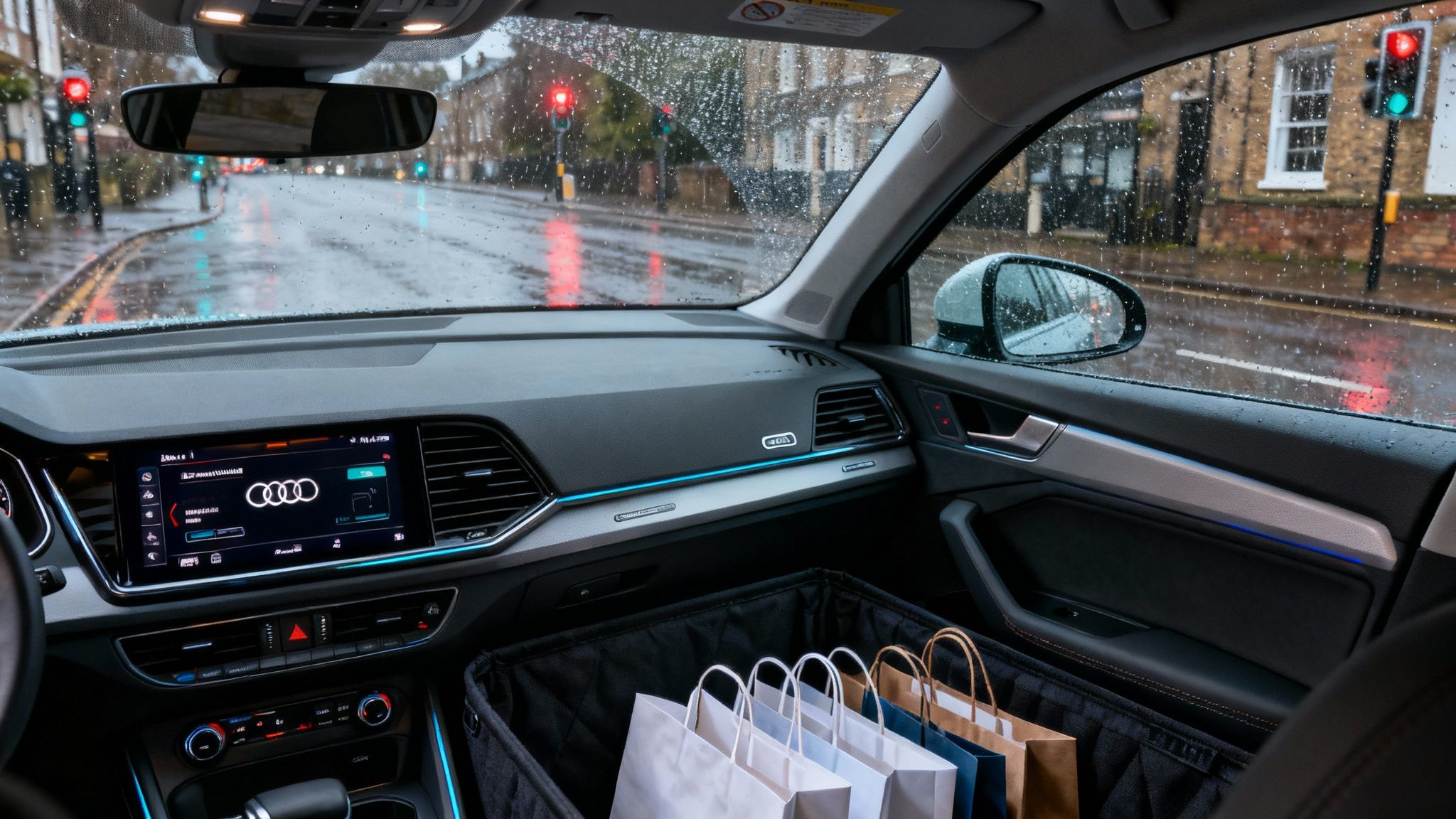
Alright, enough with the spec sheets and tax calculations. All those numbers are fine, but they don't tell you what it’s actually like to live with the thing day in, day out. Will it get on your nerves? Will it soothe your soul after a dreadful day at the office? We took the Audi Q3 TFSI e for a proper spin on Britain’s finest collection of potholes and motorways to find out.
Let's get straight to the ride quality, because this is often where hybrids stumble. The sheer weight of the batteries can make a car feel as composed as a toddler after too much sugar. Thankfully, Audi has mostly nailed it here. It’s certainly on the firmer side of comfortable, especially on the larger wheels that come with the S line trim.
You'll definitely feel the particularly nasty imperfections of our glorious road network, but it’s never jarring or crashy. On the motorway, it settles down beautifully, feeling every bit the premium cruiser. It manages to feel solid and planted without being uncomfortably stiff – a balance that’s much harder to strike than it sounds.
Inside the Cabin
Step inside, and it’s pure, undiluted Audi. The build quality is exceptional, from the satisfying 'thunk' of the closing doors to the materials that feel genuinely expensive. Everything you touch regularly feels solid and well-engineered, which is exactly what you should expect at this price point.
The seats are a particular highlight. They offer fantastic support and stay comfortable even after a long, soul-destroying slog up the M1. Visibility is good, too, making it easy to place on the road and a doddle to park in a crowded supermarket car park. It’s a genuinely pleasant place to spend time.
Audi’s MMI infotainment system is one of the better ones out there. It’s mostly controlled via a sharp, responsive touchscreen that’s fairly intuitive to use, and it comes with Apple CarPlay and Android Auto as standard. So, if you prefer, you can just bypass Audi’s own system. While it’s good, it’s not quite as user-friendly as BMW’s iDrive, which still sets the benchmark for usability on the move.
The real test of an interior isn't how it looks in the showroom, but how it functions in the chaos of daily life. The Q3's cabin is a masterclass in usability. The physical buttons for the climate control are a godsend, meaning you don't have to navigate three sub-menus just to turn up the heat. It’s the little details that make a car a joy rather than a complete pain.
Practicality and Boot Space
Now for the elephant in the room: boot space. Sticking a hefty battery under the floor was always going to have consequences, and it’s the boot that pays the price. The standard Q3 has a generous 530-litre boot, but in the TFSI e, that shrinks to a much less impressive 380 litres .
That’s a significant reduction. For context, it’s now roughly the same size as the boot in an Audi A3 hatchback. It’s still big enough for the weekly shop or a couple of suitcases, but families who need to lug around pushchairs and all the assorted clutter of life might find it a bit of a squeeze. It’s a compromise you simply have to be willing to make for the hybrid tech.
Living with the Q3 hybrid day-to-day requires a slight shift in mindset, one that applies to all plug-in vehicles. Understanding these nuances is key, a topic we explore more deeply in our guide on the realities of electric vehicle ownership in the UK.
So, would we spend our own money on one? If our daily mileage was low and we had a driveway for easy overnight charging, absolutely. The Q3 TFSI e feels properly premium, is comfortable enough for British roads, and offers a genuinely usable electric range for most people's daily commute. It successfully translates the "Audi Q3 electric" promise into a practical, real-world package, provided you can live with that smaller boot.
The Verdict: Should You Buy One?
So, here we are. The big question. Is the Audi Q3 TFSI e worth your hard-earned cash? Well, like most things in life, the answer isn't a simple yes or no. It really depends on who you are and what you need from a car. For the right person, this Audi is a masterstroke. For the wrong person, it's a slightly awkward, expensive compromise.
Let's cut to the chase. If your daily commute is under 30 miles, you have a driveway for overnight charging, and it's going on the company books, just go and buy one. Honestly, don't even hesitate. The Benefit-in-Kind tax savings are so ludicrously significant that it becomes an absolute no-brainer. You get a practical, premium SUV that runs on pennies for most of the week.
Who Is This Car Really For?
Think of the ideal owner. They do lots of short, predictable trips – the school run, the weekly shop, the commute to the local office. They love the quiet, instant shove of electric power around town but break out in a cold sweat at the mere thought of relying on the UK's shambolic public charging network for a long trip. The Q3 TFSI e is their perfect safety net, blending the best of both worlds.
On the other hand, if you're constantly pounding up and down the motorway or you live in a top-floor flat with no hope of home charging, this car will make very little sense. You’ll just be dragging a heavy, empty battery about, getting worse fuel economy than the standard petrol version and paying a premium for the privilege. Don't be that person.
The Audi Q3 TFSI e is the automotive equivalent of a spork. In some situations, it's the perfect tool, cleverly combining two functions in one. But if you only ever eat soup, you're better off just getting a spoon. This car is for the spork people.
How It Stacks Up Against Rivals
The premium compact SUV market is a proper dogfight these days. The Audi’s main challengers are the BMW X1 xDrive25e and the Mercedes-Benz GLA 250 e . The BMW arguably has the edge for keen drivers, feeling a bit sharper and more engaging on a B-road. The Mercedes, meanwhile, offers a glitzier cabin that will appeal to anyone who loves a bit of showroom sparkle.
Where the Audi really shines, particularly for UK buyers, is in its blend of user-friendly tech, solid build quality, and those all-important company car tax bands. It just strikes a brilliant, sensible balance. Its growing popularity is part of a much bigger trend; by mid-2025, battery electric and plug-in hybrids accounted for nearly 19% of all new car sales across the UK and Europe. You can dive into the numbers in this PwC report on electric vehicle sales trends.
At the end of the day, the Q3 TFSI e is a superbly executed plug-in hybrid. It's a fantastic stepping stone into electrification that doesn't force you to take the full plunge. As long as your lifestyle fits the bill, it’s one of the most compelling and sensible packages you can buy today.
Your Questions Answered
Still got a few things you're wondering about the so-called Audi Q3 Electric ? Let's clear up some of the most common queries.
Is the Audi Q3 Fully Electric?
In a word, no. The model people are often looking for is the Audi Q3 TFSI e, which is a plug-in hybrid (PHEV). It cleverly combines a petrol engine with an electric motor and battery, offering a blend of both worlds rather than a pure electric drive.
What’s the Real-World Electric Range?
Audi's official figure is up to 74 miles, which, to be blunt, you're unlikely to see unless you're coasting downhill with a tailwind. Realistically, with the air-con on and driving like a regular human being, you can expect to get between 30-35 miles from a full battery.
While that sounds modest, it's more than enough for the average UK commute. This means most of your daily trips—school runs, shopping, driving to the office—can be done on electric power alone, without touching a drop of petrol.
Can I Just Use a Normal Plug to Charge It?
You certainly can. Using a standard 3-pin household socket works, but be prepared for a long wait. It'll take about 10 hours to fully charge the battery from empty.
It's fine for an overnight top-up now and then, but if you want to make the most of the car's hybrid nature, a dedicated 7kW home wallbox is a must. That investment cuts the charging time down to a much more manageable four hours.
Is It a Good Company Car?
It's not just good; it's one of the smartest choices you can make. The Q3 TFSI e's extremely low CO2 emissions place it in a very attractive Benefit-in-Kind (BiK) tax band.
For company car drivers, this is a massive plus, translating into tax savings of thousands of pounds a year compared to a similar petrol or diesel model. It’s genuinely one of the car’s biggest selling points.
At VoltsMonster , we cut through the marketing fluff to give you the real story on electric and hybrid cars. For more brutally honest reviews and guides, check us out at https://www.voltsmonster.com.

